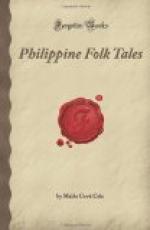[10] This seems to be peculiar to Tinguian folk-lore.
[11] Except when she is in mourning a Tinguian woman’s arms are always covered with beads placed strand above strand.
[12] The parents of a boy choose his bride when the children are very young. A great celebration is then held, and relatives and friends of both parties decide on the price to be paid for the girl. Partial payment is made at once, and the remainder goes over until the marriage proper takes place, when the boy and girl are about twelve or fourteen years of age. In this instance Ini-init makes the customary payment for his bride, though the marriage had already taken place.
[13] The friends and retainers pound rice and prepare food for all the guests who attend the ceremony.
[14] A spirit house is one of the small houses built during a ceremony.
[15] reference is probably to ancient Chinese jars.
[16] The custom, which still exists to a certain degree, was to offer food to a guest before any matter was discussed. In ancient times this was considered very necessary, as it still is among the Apayao who live north of the Tinguian. With them to refuse food is to refuse friendship.
[17] A drink made of fermented sugar-cane.
[18] The old jars possessed by the Tinguian today have notches broken in the rim, one for each generation through whose hands it has passed.
[19] When the first negotiations are made the boy’s parents offer some gift, nowadays usually a small bead. If this is accepted it signifies the willingness of the girl’s parents to consider the match.
[20] See note 1, p. 15.
[21] The music for the dances is made by beating on drums and copper gongs. A man and a woman enter the circle, each carrying a large square of cloth on outstretched arms. Keeping time to the music with their hands and feet, they move about, coming near to each other and then drawing farther apart The woman follows the movements of the man and finally places her cloth on his outstretched arms, thus ending the dance; another couple then takes their place.
[22] An interesting parallel to this is found in the Dayak legend of Limbang, where a tree springs from the head of a dead giant; its flowers are beads; its leaves, cloth; and the fruit, jars. See Roth, The Natives of Sarawak and British North Borneo, Vol. I, p. 372.
[23] Throughout the Tinguian tales the characters are frequently described as changing themselves into oil, centipedes, birds, and other forms. This power is also found among the heroes of Dayak and Malay tales. See Roth, op. cit., Vol. I, p. 312; Perham, Journal Straits Branch R., Asiatic Society, No. 16, 1886; Wilkinson, Malay Beliefs, pp. 32, 59 (London, 1906).
[24] The Tinguian place a tame rooster in an open spot in the forest and surround him with a line to which slip nooses are attached. The crowing of this bird attracts wild ones which come to fight him and are caught in the nooses.




